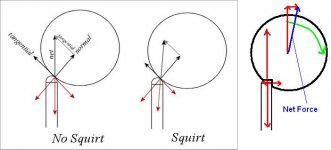Inthezone,inthezone said:Yes, the Platinum Billiards numbers are correct.
There is no mystery - the "shoot into an object ball until the PP is found where the CB spins in place test" is greatly flawed due to the throw effect.
Try this test on a break shot (50") and you will find that the true PP is only lengthened by a couple inches over PB's numbers due to the throw effect. Try the same test with the OB just 10" away and the throw effect will falsely lengthen the apparent PP by more like 2 feet. This is why it is pretty much useless in actual play.
I have metioned before another method which is simple to set up and should convince anyone that tries it:
1) set up a couple of pins slightly more than a ball apart to create a "gate"
2) put a piece of masking tape on your shaft and mark in inches from the tip.
3) Align center ball to shoot thru the gate
4) hold the bridge hand still and pivot so that as example, the tip moves to apply right english and stroke.
5) if the CB hits the left pin, shorten the PP, if it hits the right pin, lengthen it.
This so simple to set up - use two bic lighters...whatever...anything to make a "gate".
I suspect you are spot on regarding the 'Stop and Spin' shot variation from 50" v 10". This could very well be the major reason why some testers get results of 30+ inches for pivot points.
Thanks for making this seemingly obvious point clearer for me.
Colin

